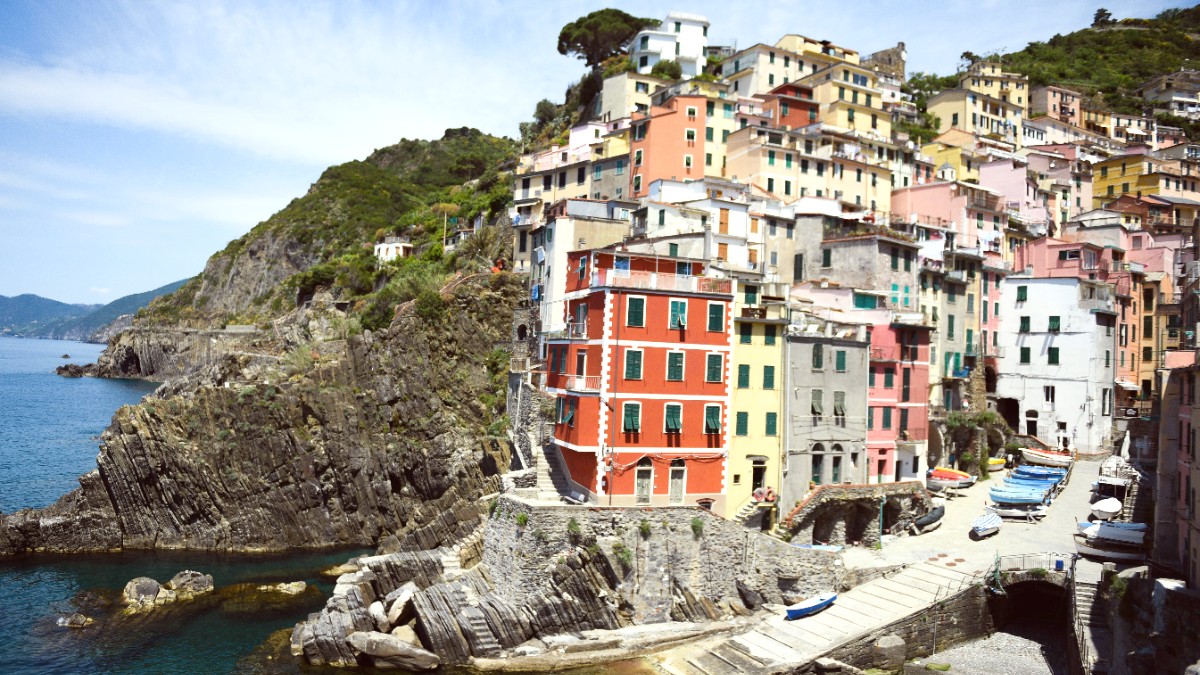
Italy
Riomaggiore experiences a Mediterranean climate, characterized by mild, wet winters and warm, dry summers.
Each season brings a different atmosphere, influencing activities and crowd levels. The landscape bursts with fresh greenery and wildflowers in spring. Summer means hot, sunny weather for beach activities. Autumn retains mild temperatures, with vineyards showing autumnal colors. Winter is mild and wetter, with reduced services.
Heavy rainfall, specifically in late autumn and winter, brings a risk of landslides. These events sometimes lead to temporary closure of hiking trails, notably the popular Via dell'Amore connecting Riomaggiore and Manarola.
Summer visitors should prepare for potential heatwaves, needing adequate hydration and Sun protection.
June-August, Easter/Holy Week
Weather for swimming and sea enjoyment. All tourist services operate at full capacity. Ferry services run frequently.
Extremely high numbers of visitors. Accommodation prices reach peak. High temperatures make strenuous hiking uncomfortable.
April-May, September-October
Pleasant temperatures for hiking. Fewer crowds. Lower accommodation prices. Most businesses open, ferries active.
Higher chance of rain. Sea too cool for swimming early/late season. Trails can still have significant numbers.
November-March
Authentic local experience with few tourists. Lowest prices. Tranquility of villages. Manarola Nativity scene.
Many tourist businesses closed. Some hiking trails may close. Ferry service suspended/reduced. Unpredictable weather.
Hiking conditions are best in April-May and September-October for comfortable temperatures and fewer crowds. Swimming and beach activities are ideal from June-August, with the warmest sea temperatures and most sunshine.
Photography benefits from early morning or late afternoon light during shoulder seasons for beautiful shots with fewer people. Wine tasting aligns with the harvest season, September-October, offering vineyard tours and fresh wine experiences.
April-May, September-October.
June-August.
Shoulder seasons, early morning/late afternoon.
September-October (harvest season).
December-January (Low Season).
Italy operates under the Schengen Agreement; entry requirements are standard across 27 European countries.
Many non-EU/EEA/Swiss citizens require a Schengen visa for stays up to 90 days within any 180-day period. This visa allows travel throughout the Schengen Area.
Citizens from the US, Canada, Australia, NZ, UK, Japan, and most South American countries do not need a Schengen visa for tourist stays up to 90 days.
No specific entry fees for tourists upon arrival at Italian borders. Standard immigration procedures apply at international airports.
Costs vary considerably based on travel style and preferences.
The official currency is the Euro (€, EUR). ATMs (Bancomat) are available in Riomaggiore, more widely in La Spezia or Levanto. ATMs offer favorable exchange rates.
Credit cards (Visa, Mastercard) are widely accepted. Cash is useful for small purchases and smaller, family-run establishments. Always inform your bank of travel plans to avoid card holds.
Daily costs: €60-€100. Hostel dorm or basic guesthouse. Meals: street food, picnics, simple pasta. Cinque Terre Card for transport/hiking. Free exploration activities.
Cost-effective sightseeing and local experiences.
Limited dining choices and fewer amenities.
Daily costs: €100-€200. Comfortable hotel/apartment. Dinners at local trattorias. Frequent train/ferry travel, occasional paid attractions.
Balanced comfort, local cuisine, and exploration.
Still mindful of costs, not all premium services.
Daily costs: €200+. Boutique hotels, private villas. Fine dining. Private transfers, personalized tours, boat excursions. Full flexibility.
Premium experiences and complete comfort without compromise.
Higher costs overall.
| Category | Low End | High End |
|---|---|---|
| Accommodation (per night) | €30 (hostel dorm) | €600+ (luxury villa) |
| Meals (per person) | €5 (street food) | €150+ (fine dining) |
| Transportation (per ride) | €4 (single train ticket) | €15 (ferry leg) |
Italy offers good healthcare facilities, and preparation is important.
No specific vaccinations for Italy. Ensure routine ones (MMR, Tdap, polio, flu) are current. Consult a doctor or travel clinic for personalized advice.
Apply Sunscreen SPF 30+, wear hats, seek shade during peak hours (12-3 PM).
Carry a reusable water bottle; refill at public fountains. Steep climbs increase water needs.
Prevention of minor injuries with proper footwear and basic first aid.
Hiking on uneven trails can lead to cuts, scrapes, or sprains. Wear sturdy footwear. Pack a Basic first aid kit with Band-aids, antiseptic wipes, pain relievers, and blister treatment.
Ticks are present in wooded areas; check for them after outdoor activities. Mosquitoes are common in warmer months; consider packing Insect repellent.
Always prioritize personal safety and well-being during your travels.
Universal European emergency number for police, ambulance, fire.
For minor issues, visit a Farmacia (pharmacy). Closest hospital is Ospedale Sant'Andrea in La Spezia.
Highly recommended for non-EU citizens. EU citizens should carry their European Health Insurance Card (EHIC).
Riomaggiore and Cinque Terre are very safe with low crime rates. Petty crime (pickpocketing) can occur in crowded tourist areas.
Travel insurance is strongly recommended for all visitors. Look for a policy with comprehensive coverage.
Medical emergencies, evacuation, unforeseen illnesses/injuries.
Interruption or cancellation for non-refundable expenses due to covered reasons.
Lost/delayed baggage compensation. Personal liability for accidental damage/injury.